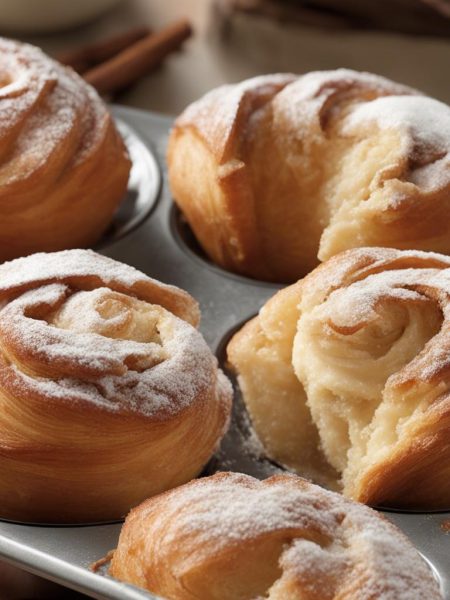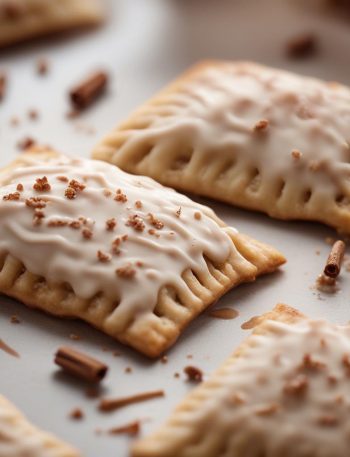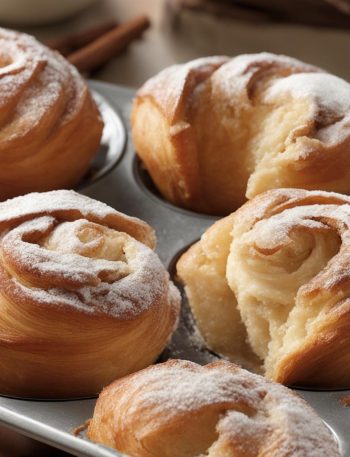
Use this in-depth tutorial to learn how to make homemade berry turnovers with a from-scratch puff pastry variation and a jammy mixed berry filling. The pastry dough comes together using a “rough puff” method where you carefully work butter into your dry ingredients and then fold and flatten the dough many times to create countless flaky layers. Unlike the breakfast pastries dough, this dough does not require any yeast and unlike croissants and traditional puff pastry, this dough does not require laminating with a separate layer of butter. Rather, the layers and crisp flakiness come from the particular mixing and folding methods. The turnovers are lightly sweetened and perfect for dessert or alongside a cup of coffee.
Using this simplified method and a handful of basic ingredients, you’ll be amazed that you can make puff pastry from scratch within just a few hours. I’m still stunned with this outcome! And after you master these flaky berry turnovers, you’ll enjoy using this dough wherever you use a single pie crust or store-bought puff pastry.
Berry Turnovers Details
- Flavor: These berry turnovers are like mixed berry hand pies, but with a crispy, airy, and buttery dough. I would actually compare these more to store-bought Toaster Strudels but 100x better because they’re flakier, crispier, homemade, and not nearly as sweet. Great for breakfast or dessert! Vanilla icing is optional, but it’s a wonderful finishing touch, especially since these aren’t overly sweet in the first place. Each bite is mostly flaky dough with just a touch of berry filling. (Don’t want to over-fill those turnovers!)
- Texture: You know when you bite into golden brown baked puff pastry and you actually hear that loud CRISP? The layers crackle, pop, and quite frankly, make a big old mess on your fingers and plate? That’s exactly what you’ll experience with these homemade berry turnovers. This pastry is one of the FLAKIEST doughs I’ve ever worked with and comes close to croissant bread territory. (But made in a fraction of the time!) Pair this buttery pastry with a jammy berry filling and you’ll have a professional bakery-style treat made in the comfort of your home.
- Ease: I categorize this as an intermediate baking recipe. You need to flatten and fold the dough 6x, but there’s no chilling between each time so the recipe moves quicker than traditional homemade puff pastry.
- Time: The berry filling comes together in minutes over the stove, but the puff pastry will take you a few hours since there’s about 2-3 hours of chill time required. By this time the berry filling will have cooled down and you’ll be all set to shape, fill, and bake those irresistible turnovers. Set aside an afternoon for this fun baking project!
What is Rough Puff Pastry?
Have you ever heard of “rough puff” pastry? It’s become a really popular method with professionals and home bakers because it produces bakery-style puff pastry with oodles of buttery, flaky layers. Cookbook author and chef Claire Saffitz has a wonderful recipe for it and the term “rough puff” is often used on The Great British Bake Off! The trick is to work large pieces of cold butter into dry ingredients (flour and often a bit of sugar and salt), and hydrate it all with ice cold water. Sometimes bakers grate butter into the mix or use a food processor. There’s lots of ways to make rough puff pastry.
With this recipe, I stick with cold cubes of butter and use my hands to rub the butter into the flour mixture. Your hands are your best tool and method here because it’s nearly impossible to over-mix the dough this way. If the dough is over-mixed and you break down the butter too much, you’ll lose layers.
- Can I use a food processor, pastry cutter, or other mixer? I do not recommend it. These tools slice down the butter too much and you’ll lose a lot of flaky layers. I tried and it’s not worth it because the result is closer to a greasy pie dough than a layered puff pastry. (Still good, but not the goal here.)
How Is This Different From Pie Crust and Yeasted Pastry Dough?
Pie crust, while buttery and flaky, is not nearly as light, doughy, and crisp as this shortcut puff pastry. Yeasted pastry dough, such as something we can use for croissants or a blueberry cream cheese pastry braid, contain yeast. This recipe simply relies on big chunks of cold butter (lots of it) and folding.
Rolling & Folding the Dough
After you prepare the dough and chill it in the refrigerator, you will begin rolling it out with a rolling pin and folding it like a business letter, rolling it out again, folding again, and so on. You will roll + fold it a total of 6 times.
. *Note that I sliced a sliver off the end so I could show you this!
Just 5 Ingredients in the Dough
This shortcut pastry dough comes together with flour, sugar, salt, cold butter, and cold water.
- Why do the butter and water have to be cold? It’s important for the butter to stay cold so it doesn’t melt and soak up all the flour. We want the butter to stay solidified as we roll, shape, fold, and flatten this dough because if it melts before baking, you lose all the flakes. Game over. You see, when the butter melts in the oven, it creates steam and that steam separates the dough into multiple flaky layers. Warm fat will lend a much denser, flatter turnover.
The dough requires 2 separate refrigeration steps, but the 2nd one is only 15 minutes. You can easily make this dough in a few hours or over the course of 2 days. I always appreciate make-ahead dough where you have plenty of options in terms of timing. You can also freeze the dough, too. (See recipe below.) After both refrigeration steps, you can use this dough in many recipes such as these turnovers, butternut squash tart, cranberry brie puff pastry tarts, mushroom tarts, or even these homemade cinnamon palmiers.
Homemade Berry Turnovers Filling
This thickened berry filling is adapted from these strawberry sauce and blueberry sauce recipes. I reduced it down so we have just enough for the turnover recipe below. It’s sweet like jam with big chunks of delicious berries. Feel free to use frozen berries, too. You could also use the filling from these apple turnovers and top them with salted caramel for an extra special treat.
Tip: Make sure it cools completely before using as the filling in your turnovers. My recipe below works this into the instructions.
See Your Turnovers!
.. In this step, I’m briefly/barely rubbing the butter into the flour to start combining them. This step is only possible if the butter is very cold because if the butter is warm, you’ll end up with paste.
. That’s great! Now let’s add the ice cold water 1 Tablespoon at a time, using our hands to toss it all together. (Note that I usually start with 2 Tablespoons of water before I begin tossing together.) You can use a spatula or spoon for tossing, but I really do recommend your hands so you get a good feel of the dough.
. As the dough begins to hydrate after about 4 Tablespoons of water, you can start lightly squeezing or clumping the dough together with your hands to help bring it together. Mixture will still be very shaggy, as you can see.
. Do not add any more or any less. If your dough reaches this point before adding 6 Tablespoons of water, your butter was likely too warm. You can continue with the recipe with less water, but the dough will not be as flaky.
. There will still be large chunks of butter. That’s great! Begin patting it down with your hands until it’s about 3/4 – 1 inch thick, about a 5×8 inch rectangle:
. This is exactly how we fold biscuits dough, too!
1st refrigeration: Now use your hands to gently flatten and smooth out any cracks in your dough “business letter” then wrap it in plastic wrap, aluminum foil, parchment paper, or place in a sealed container, and refrigerate for at least 2 hours and up to 24 hours.
Now it’s time for the rolling pin. Remove dough from the refrigerator and begin rolling out.
You’re going for a 1/2 inch thick, about a 6 inch wide and 12 inch tall rectangle. The exact dimensions are not important, but the thickness is. Fold the rectangle into thirds like a business letter:
Turn it clockwise or counter clockwise, then grab your rolling pin again:
Repeat this 5 more times, for a total of 6 rolling out + folding sessions. After the 6th time, wrap the dough up again and chill for at least 15 minutes and up to 24 hours.
Success Tip: If the dough “business letter” is so thick or impossible to roll out, cover it with a clean kitchen towel and let it rest for 5 minutes before trying again. The butter just needs to slightly soften. Lightly flour your work surface whenever necessary.
Now the dough is packed with layers upon layers of buttery dough. Roll it out to a 12-inch square. Cut into 9 4-inch squares.
Place the squares onto 2 lined baking sheets. Place 1 heaping Tablespoon of berry filling in the center of each.
Fold over to create a triangle. Some filling is bound to leak out. Don’t worry about it! Crimp edges with a fork. If dough has gotten too soft at this point and the dough is too sticky to crimp shut, stop and refrigerate everything for 10 minutes. You want to make sure you have a tightly sealed turnover to help prevent it from spilling out in the oven.
After shaping each turnover and crimping the edges, I strongly recommend refrigerating them for at least 15 minutes as you preheat the oven and make your egg wash. This helps guarantee they will hold shape.
Cut slits into the tops of shaped turnovers and brush with egg wash (egg + milk or just use milk). Sprinkle with coarse sugar—I usually use Sugar in the Raw or these coarse sugar sprinkles, both of which can be found in the baking aisle of major grocery stores.
Bake until golden brown. Butter will definitely leak from this dough, so don’t get nervous if you see that happening in the oven.

Homemade Berry Turnovers Recipe
Description
These homemade berry turnovers use a shortcut version of traditional puff pastry dough that's often referred to as rough puff pastry. Each bite is mostly flaky dough with just a touch of berry filling. Make sure the butter is very cold before beginning the dough.
Ingredients You’ll Need
Instructions
- Whisk the cornstarch and water together until all the cornstarch has dissolved. (I just use a fork to mix–very easy.) Place the berries, sugar, cornstarch mixture, and lemon juice into a small saucepan over medium heat. Using a wooden spoon or rubber spatula, stir the mixture as it cooks. Break up some of the berries as you stir. Bring it to a simmer and allow to simmer for 3 minutes, stirring constantly. Remove pan from the heat and cool completely. The mixture will thicken as it cools. Once cool, filling can be covered and refrigerated for up to 5 days before using. Makes 3/4 cup of filling.
- Whisk the flour, sugar, and salt together in a large bowl. Place the cold and cubed butter on top.. You do not want to break down the butter too much in this step. This step is only possible if the butter is very cold because if the butter is warm, you’ll end up with paste. I do not recommend a food processor, pastry cutter, or mixer for this step because it will break down the butter too much.
- At this point, the butter is still in large cubes/chunks. Begin adding the ice cold water 1 Tablespoon (15ml) at a time until dough forms 1 large shaggy clump in your bowl. Use your hands to toss the mixture together after you add each Tablespoon. (I usually start with 2 Tablespoons (30ml) of water before I begin tossing together.) You can use a spatula or spoon for tossing, but I really do recommend your hands so you get a good feel of the dough. As the dough begins to hydrate after about 4 Tablespoons (60ml) of water, you can start lightly squeezing or clumping the dough together with your hands to help bring it together.. If your dough feels sticky and wet before adding 6 Tablespoons of water, your butter was likely too warm—you can continue with the recipe, but the dough will not be as flaky.
- Pour the shaggy clump of dough out onto a lightly floured work surface. There will still be large chunks of butter at this point and that’s a good thing. Begin patting the dough down with lightly floured hands until it’s 3/4 – 1 inch thick, about a 5×8 inch rectangle. Fold the dough into thirds as if you were folding a business letter. Use your hands to gently flatten and smooth out any cracks in your dough. Wrap it up tightly in plastic wrap, parchment paper, or aluminum foil, or place into any tightly sealed container.
- Refrigerate dough for at least 2 hours and up to 24 hours.
- Take the dough out of the refrigerator to begin the “rolling and folding” process. If the dough chilled for longer than about 3 hours, it’s likely very stiff so let it rest for about 5 minutes before you begin rolling. Lightly flour a work surface. The dough gets sticky, so make sure you have more flour nearby as you roll and fold. Use your hands to gently flatten the dough into a small square. Using a rolling pin, roll the dough into a 6 inch wide and 12 inch tall rectangle that’s 1/2 inch thick. The exact dimensions are not important, but the thickness is. As you roll, it’s best to flip the dough over once or twice to make sure it’s not sticking to your work surface. Lightly flour your work surface as needed. Fold the rectangle into thirds as if it were a business letter..) Turn it clockwise or counter clockwise and roll it out into a 6×12 inch 1/2 inch thick rectangle again. Then, fold into thirds again. Turn it clockwise or counter clockwise. You’ll repeat rolling and folding 4 more times for a total of 6 times.
- Wrap up/seal tightly and refrigerate for at least 15 minutes and up to 24 hours. You can also freeze the dough at this point. See freezing instructions.
- Line two large baking sheets with parchment paper or silicone baking mats. Rimmed baking sheets are best because butter may leak from the dough as it bakes. If you don’t have rimmed baking sheets, when it’s time to preheat the oven, place another baking sheet on the oven rack below to catch any butter that may drip.
- Take the dough out of the refrigerator to begin the shaping steps. Lightly flour a work surface. Using a rolling pin, roll dough into a 12-inch square. Using a pizza cutter or sharp knife, cut into 9 4-inch squares. Transfer squares to prepared baking sheets. (4 on one, 5 on the other.)
- Spoon 1 heaping Tablespoon of filling into the center of each square. Fold one corner over the filling to make a triangle. If some chunky filling has seeped out, use a fork to push it back in if you can. Using a fork, crimp the edges of the turnovers together to seal. If the dough has become too warm and sticky to crimp, refrigerate the triangles for 10 minutes. You want to make sure you have a tightly sealed turnover to help prevent filling from spilling out in the oven.
- Chill the shaped turnovers in the refrigerator, covered or uncovered, for at least 15 minutes and up to 1 hour (or freeze, see freezing instructions below). You can preheat the oven and make the egg wash (next steps) as they finish up chilling.
- Preheat oven to 400°F (204°C).
- Whisk the egg and milk together. Brush on each turnover. Cut 3 slits into the tops of each to allow steam to escape. If desired, sprinkle with coarse sugar.
- Bake for 22-25 minutes or until golden brown on top and around the edges. Some butter may leak from the dough, that’s completely normal and expected. Feel free to remove the baking sheets from the oven halfway through baking and brush the dough with any of the leaking butter, then place back in the oven to finish baking. (That’s what I do!)
- Remove baked turnovers from the oven. Cool for at least 5 minutes before icing/serving. Centers will be hot.
- Drizzle with vanilla icing if desired.
- Cover leftover iced or un-iced turnovers and store at room temperature for 1 day or in the refrigerator for up to 5 days. Or you can freeze them for up to 3 months. Thaw before serving. Before enjoying, feel free to reheat leftover iced or un-iced turnovers in the microwave for a few seconds until warmed.






